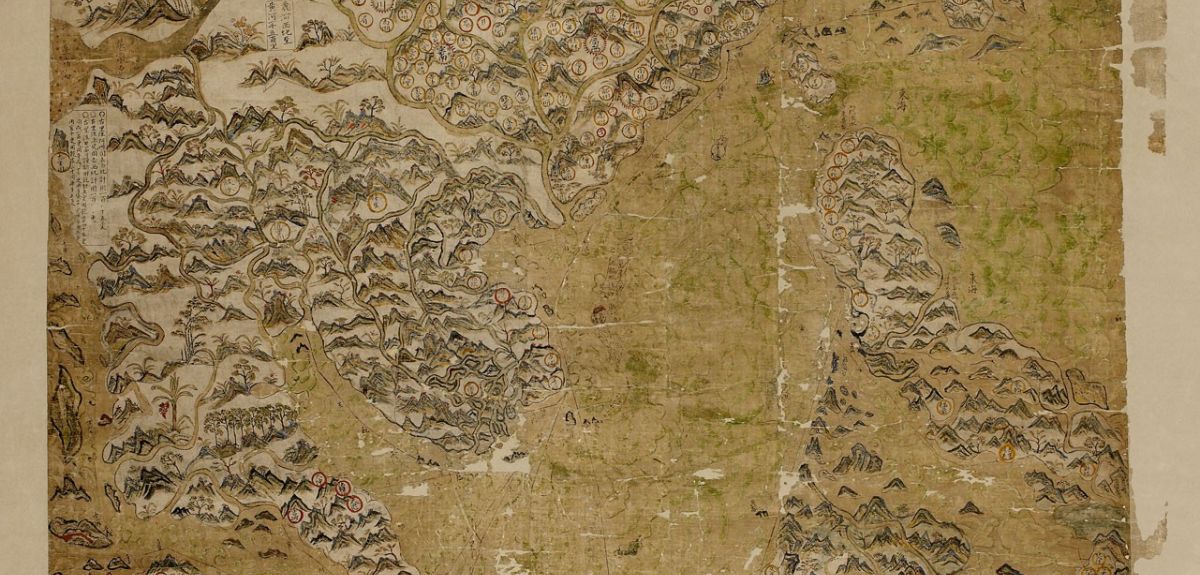
A new interdisciplinary take on an old Bodleian treasure
It was once described as 'a very odd map of China'. Today, the 17th-century Selden Map – which London lawyer John Selden bequeathed to Oxford in 1659 – is one of the treasures of the Bodleian Library.
David Helliwell, curator of Chinese collections at the Bodleian, explained: 'We don't know exactly when the map was made, nor do we know exactly where it was picked up in the Far East, but we imagine that it was probably made in 1620. It was acquired by a merchant of the East India Company and brought to London, where it passed into the hands of Selden. But we don't know exactly how, and we don't know exactly when.'
The newly-launched Oxford Research Centre in the Humanities (TORCH), which seeks to promote interdisciplinary collaboration, invited a number of scholars from different disciplines to cast their eye over the map. The resulting short film throws up a wide range of intriguing, interrelated perspectives.
Dr Kate Bennett, an English lecturer with a research interest in antiquarianism, was one of the academics invited to have their say. She said: 'What we can certainly say is that Selden knew a very interesting potential source of study and scholarship when he saw one. His works were things that he had collected to help his own scholarship, which was formidable.'
Rana Mitter, professor of the history and politics of modern China, hailed the value of the Selden Map in providing historical context for our understanding of the region today. He said: 'One of the things that has emerged from the research I have done is that things that we consider to be natural circumstances – the idea perhaps that China and Japan might be in conflict or hostile with each other – are actually often historically determined and often rather short-lasting. In other words, looking at the map gives you that longer-term view – a reminder that the kind of understanding we have of this immensely important region has to be informed by an understanding that trade routes, relationships, commerce and people engaging with each other has a long history. The map is a marvellous example of that.'
Ros Ballaster, professor of 18th-century studies, added: 'There was a lot of enthusiasm in the late 17th and early 18th centuries to find ancient cultures other than Greek and Roman classical culture, and that's a strong line in talking about China through the 17th and 18th centuries – as an alternative classical culture. I think that's what Selden is, in a way, trying to collect.'
As well as being an interesting object from a historical perspective, the Selden Map is also an important piece from an artistic point of view. Ros Holmes, a researcher in contemporary Chinese art, said: 'One of the most interesting things for me about the Selden Map is the sheer richness of the detailing itself. What first appears to be a 17th-century map about Chinese trade routes is actually a more complicated art historical object that attests to cross-cultural flows of knowledge and an exchange of ideas – not just about pictorial representation but about how China visualised itself in relation to the rest of the world.'
Mr Helliwell agreed about the visual impact of the map. 'It was probably a map that almost had a half aesthetic function and it was probably displayed in the house of a rich merchant,' he said. But for Mr Helliwell the most striking aspect of the map lies in its scope, and what it tells us about commerce in this period. The map extends to the whole of the Far East, with China only in the top half and the South China Sea at the centre. He said: 'This is a map drawn by ordinary people. It’s drawn by tradesmen – tradesmen who simply wanted to illustrate the routes on which they plied their trade.'
Image of the Selden Map courtesy of the Bodleian Library.